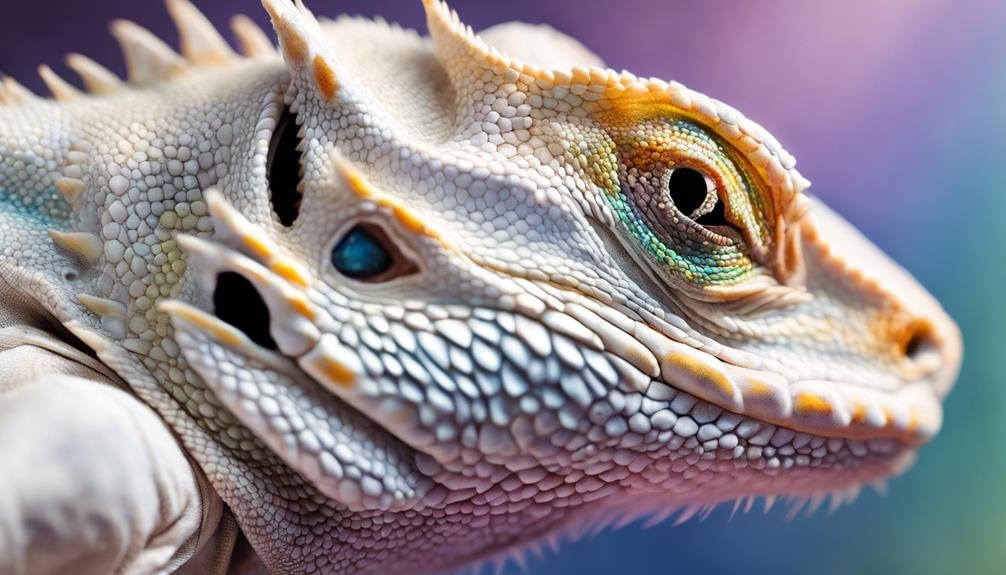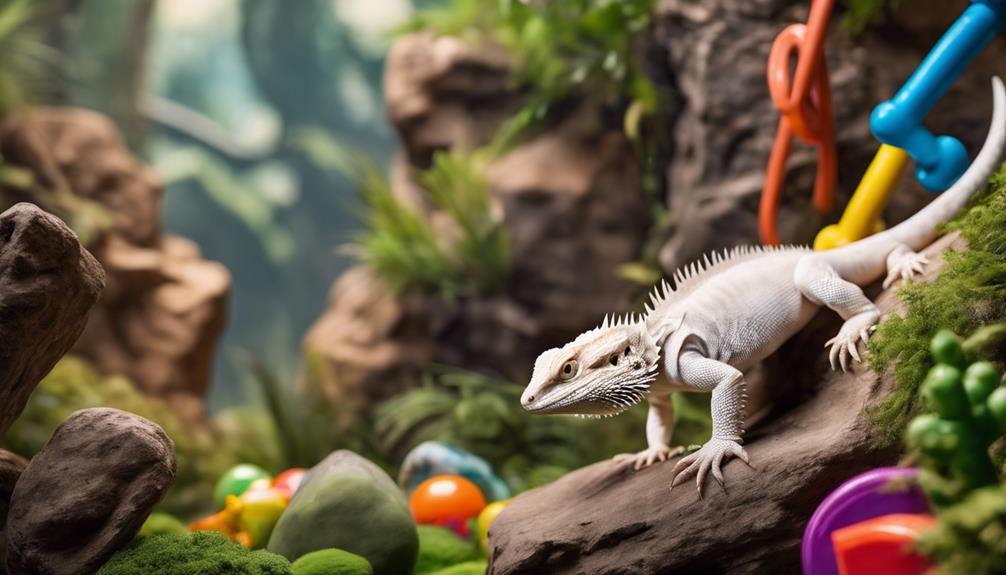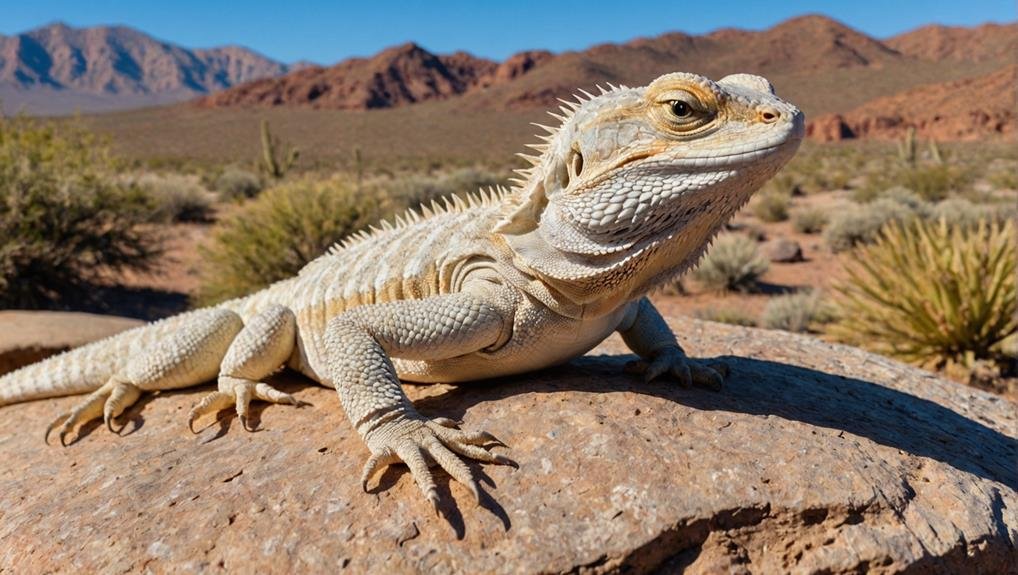When you first encounter a white-bearded dragon, you’re likely struck by its striking, almost otherworldly appearance. This isn’t just about aesthetics; their distinct coloration results from an intriguing mix of hypomelanism and leucism. But owning one isn’t just about admiring its beauty; it requires creating the right habitat, maintaining proper temperature and lighting, and providing a balanced diet. Have you ever wondered what specific care routines are crucial for their well-being or what subtle signs might indicate a health issue? There’s so much more to explore about these essential creatures.
Key Takeaways
- White-bearded dragons owe their unique coloration to hypomelanosis and leucism, which result in lighter scales and a brilliant white appearance.
- Habitat setup should include a basking spot at 95-105°F and a cooler zone at 75-85°F.
- They require 10-12 hours of UVB light daily for proper vitamin D synthesis and calcium absorption.
- A balanced diet of leafy greens, insects, and limited fruit is essential for their nutrition.
- Regular health monitoring includes checking appetite, body condition, skin coloration, and shedding patterns.
Genetics and Coloration


Understanding the unique genetics and coloration of white-bearded dragons is captivating. These enchanting reptiles owe their striking appearance to two key genetic traits: hypomelanosis and leucism.
Hypomelanism reduces melanin production, giving the white-bearded dragon a lighter, more delicate coloration than its darker counterparts. This reduction in melanin means that their scales and skin are much lighter, but they still retain the natural pigmentation of their eyes.
Leucism, on the other hand, causes a partial or complete loss of pigmentation across the body. In the case of the white-bearded dragon, this results in their brilliant, almost otherworldly white color. Unlike albinism, which affects eye pigmentation, leucism doesn’t alter the color of the eyes, so a white-bearded dragon will still have normally pigmented eyes.
The combination of hypomelanosis and leucism creates the distinctive, visually appealing white coloration that makes these dragons stand out. This unique blend of genetic factors gives the white-bearded dragon its mesmerizing appearance and highlights the species’ incredible diversity. Embracing these genetic traits’ complexity helps you appreciate these remarkable creatures’ beauty and uniqueness.
Habitat Setup
Creating an ideal habitat setup for your white-bearded dragon is vital for health and happiness. Proper Bearded Dragon Care involves creating correct temperature gradients within their enclosure. You’ll want to secure a basking spot with temperatures between 95-105°F where your dragon can soak up heat, which is important for digestion and overall well-being. At the opposite end, maintain a cooler zone ranging from 75-85°F to provide a comfortable resting area. During nighttime, nighttimes should not drop below 65°F to keep your dragon cozy.
A well-balanced environment mimics their natural habitat and promotes healthy behaviors. Providing 10-12 hours of UVB light daily is essential for vitamin D synthesis and calcium absorption, preventing metabolic bone disease.
Here’s a quick reference table to guide you:
| Area | Temperature Range | Purpose |
|---|---|---|
| Basking Spot | 95-105°F | Heat absorption and digestion |
| Cooler Zone | 75-85°F | Comfortable resting area |
| Night-time | AbNighttime | maintain well-being while sleeping |
Temperature and Lighting


Accuracy is key when setting up the temperature and lighting for your white-bearded dragon. Your scaly friend thrives under specific conditions that mimic its natural habitat. Start by creating a basking spot that maintains a temperature between 95-105°F. This allows your white-bearded dragon to thermoregulate effectively.
To guarantee a comfortable gradient, the cooler end of the tank should range between 75-85°F. This temperature variation lets your dragon move between warmer and cooler zones as needed.
Temperatures must stay above 65°F at night. Keeping the nighttime temnighttimestable ensures your white-bearded dragon stays healthy and comfortable.
Proper lighting is equally significant. Your dragon requires 10-12 hours of UVB light each day. This exposure is essential for vitamin D synthesis and calcium absorption, which are necessary for strong bones and overall health.
Position your UVB light correctly to maximize its benefits. Ensuring the right lighting and temperature will set the foundation for a happy, healthy white bearded dragon. Paying close attention to these details will create an environment where your pet can thrive.
Diet and Nutrition
A well-rounded diet is vital for keeping your white-bearded dragon in peak health. Bearded dragons eat bananas, but you should offer them sparingly due to the high sugar content, which can lead to weight gain. Their diet should primarily consist of vegetables, fruits, and insects to ensure they get all the necessary nutrients.
Leafy greens like kale and collard greens are excellent sources of vitamins and minerals. They should make up a significant portion of their diet.
Insects such as crickets, mealworms, and roaches are essential protein sources and should be fed regularly to support muscle development and energy levels.
While fruits can be a tasty treat, they should be limited to avoid excessive sugar intake. You might occasionally offer fruits like berries or melons in addition to bananas.
Always monitor their diet closely and consult a vet if you notice any changes in their appetite or behavior, such as a black beard, which can indicate stress or health issues.
Mental Stimulation


Ensuring your white-bearded dragon gets enough mental stimulation is important for its well-being. Mental stimulation promotes natural behaviors, physical activity, and overall health.
One effective way to achieve this is by incorporating habitat enrichment into your dragon’s living space. Adding climbing structures such as branches and rocks encourages exercise and mimics their natural environment, keeping them physically and mentally engaged.
Interactive toys are another fantastic way to keep your white-bearded dragon stimulated. Simple objects like balls or puzzle feeders can provide hours of engagement. These toys keep your dragon entertained and help foster problem-solving skills vital for their mental development.
Varied habitat setups can also enhance your dragon’s mental well-being. Changing the layout of their enclosure periodically can provide new challenges and prevent boredom. This variety encourages exploration and keeps them curious, which benefits their mental health.
Health Monitoring
To maintain your white-bearded dragon’s health, you should regularly monitor their physical health and behavior. Check for any changes in eating habits, activity levels, and physical appearance, and don’t forget to schedule annual vet check-ups. By staying observant, you’ll catch potential issues early and guarantee your pet thrives.
Regular Vet Check-ups
They are wondering why regular vet check-ups are important for your white-bearded dragon. These appointments are necessary to monitor their overall health and detect potential issues early. White-bearded dragons, like all pets, can face various health challenges, from nutritional deficiencies to skin conditions. Regular vet check-ups guarantee that problems are caught and treated promptly, preventing minor issues from becoming major ones.
During these visits, a vet will assess your dragon’s weight, skin condition, behavior, and overall vitality. This thorough evaluation helps ensure your pet is thriving.
Vets can also provide valuable guidance on proper care, diet adjustments, and habitat setup specific to white-bearded dragons. This expert advice is essential for maintaining your dragon’s well-being.
Routine check-ups contribute significantly to your white-bearded dragon’s happy and healthy life. They help you stay on top of your pet’s needs and ensure they receive the best possible care.
Observing Behavioral Changes
Please pay close attention to your white-bearded dragon‘s behavior; this is a crucial indicator of their health. Monitor changes in activity levels, appetite, and basking behaviors. Dragons require consistent routines, and deviations can indicate health issues.
For instance, if your bearded dragon’s head bobbing becomes excessive or they display unusual aggression, these could be signs of stress or illness.
Lethargy and loss of appetite are also red flags. Exotic reptiles like white bearded dragons thrive on regular eating and basking habits. If they suddenly stop eating or basking, acting quickly is vital.
Regularly observe their interactions with their environment and response to handling. These behaviors provide insights into their well-being.
To monitor their health, log daily activities, eating habits, and overall behavior. This record helps identify any persistent changes over time. If you notice concerning behavioral shifts, seek veterinary care promptly.
Early intervention can address potential health problems and maintain your dragon’s good health. Remember, consistent observation and quick action are crucial to preserving the well-being of your exotic reptile.
Monitoring Physical Health
Keeping a close eye on your white-bearded dragon’s physical health is important to maintain its health and happiness. Monitoring involves regular checks for signs of illness, like changes in appetite, behavior, or appearance. This is particularly essential for a bearded dragon baby or a leatherback bearded dragon, as they are more vulnerable to health issues.
Please pay attention to your dragon’s body condition, skin coloration, and abnormalities like lumps or bumps. Regularly weighing your dragon helps track its growth and overall health. Hypo-bearded dragons, known for their unique coloration, should be monitored closely for any changes that might indicate health problems.
Shedding is another significant aspect. Ensure they shed properly and address any issues promptly to maintain their skin health. Hydration is important; observe their water consumption and make sure they always have access to clean water.
Here’s a quick reference table to guide your health monitoring:
| Aspect | What to Check For | Action Needed |
|---|---|---|
| Appetite | Changes in eating habits | Consult a vet if persistent |
| Body Condition | Weight and muscle tone | Adjust diet as needed |
| Skin Coloration | Consistency and brightness | Look for signs of illness |
| Lumps/Bumps | Abnormal growths | Seek veterinary advice |
| Shedding Patterns | Proper and complete shedding | Assist with shedding issues |
Conclusion
By understanding the genetics and coloration of your white-bearded dragon, you can appreciate their unique beauty. Set up their habitat with proper temperature gradients and UVB lighting, and feed them a balanced diet of vegetables, fruits, and insects. Don’t forget to provide mental stimulation with habitat enrichment and interactive toys. Regularly monitor their health and behavior to catch any issues early. With attentive care, your white-bearded dragon will thrive and bring you joy.
FAQs
1. Are White Bearded Dragons Rare?
Yes, they’re rare due to specific genetic mutations. Breeding possibilities are limited, making them highly sought after. Their striking appearance and rarity boost their popularity among collectors, making them a prized addition to any collection.
2. How Much Is a Pure White Bearded Dragon?
You can expect to pay between $250.00 and $750.00 for one, depending on the genetics involved, the breeder’s reputation, and preservation efforts. Breeding possibilities also affect the price, as high-quality genetics are rare.
3. What Is the Rarest Colour of Bearded Dragon?
The rarest color of a bearded dragon is white. Its unique appearance results from the genetics of white dragons and specific breeding techniques. You must maintain proper habitat requirements to sustain their health.
4. How Much Does an Albino Bearded Dragon Cost?
Albino bearded dragons cost between $250.00 and $750.00. Price comparison shows market trends vary due to breeding challenges and genetic mutations. Popular misconceptions about their care requirements can greatly affect these prices.


